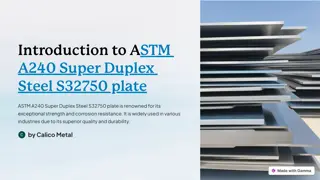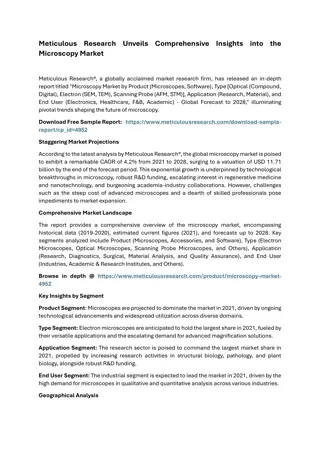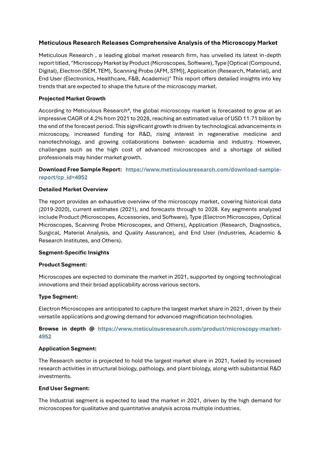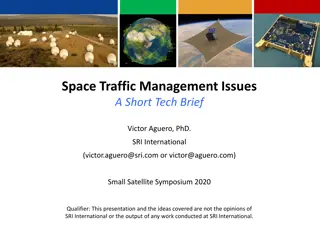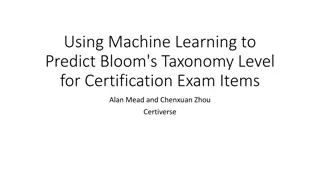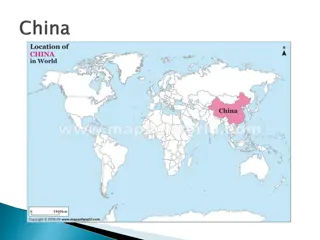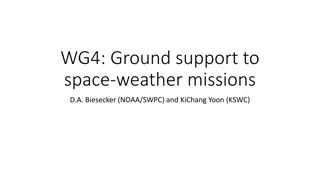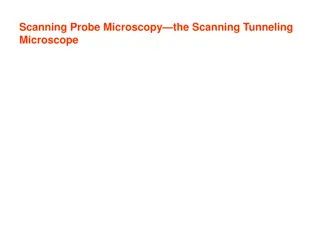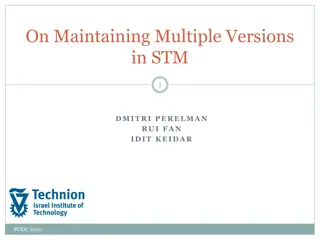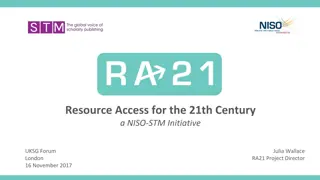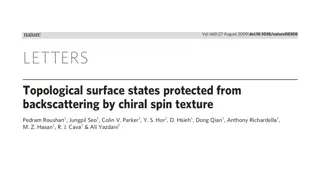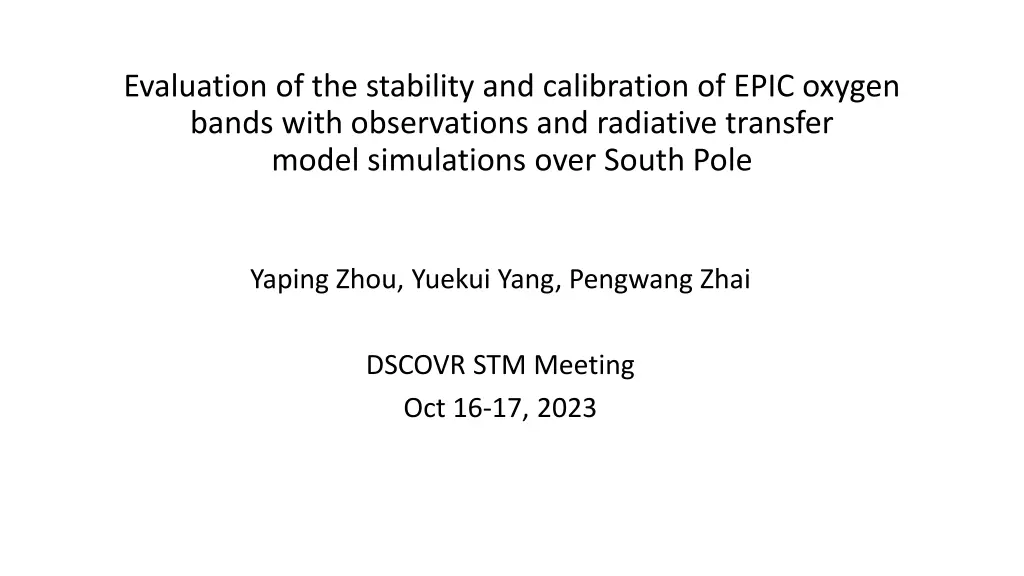
EPIC Oxygen Band Stability and Calibration Evaluation Over South Pole
Explore the evaluation of the stability and calibration of EPIC oxygen bands using observations and radiative transfer model simulations over the South Pole. The study focuses on the A-band and B-band characteristics, monitoring their stability, and comparing EPIC observations with RTM simulations.
Download Presentation

Please find below an Image/Link to download the presentation.
The content on the website is provided AS IS for your information and personal use only. It may not be sold, licensed, or shared on other websites without obtaining consent from the author. If you encounter any issues during the download, it is possible that the publisher has removed the file from their server.
You are allowed to download the files provided on this website for personal or commercial use, subject to the condition that they are used lawfully. All files are the property of their respective owners.
The content on the website is provided AS IS for your information and personal use only. It may not be sold, licensed, or shared on other websites without obtaining consent from the author.
E N D
Presentation Transcript
Evaluation of the stability and calibration of EPIC oxygen bands with observations and radiative transfer model simulations over South Pole Yaping Zhou, Yuekui Yang, Pengwang Zhai DSCOVR STM Meeting Oct 16-17, 2023
Objectives EPIC s O2 bands: A-band (764nm, 780nm) and B-band (688nm, 680nm) play significant roles in EPIC cloud (CM, CEP) and aerosol (height, cloud screening) retrieval algorithms. Due to lack of inflight calibration, 680nm and 780nm calibration uses other in-space LEO/GEO instruments such as MODIS, MISR, and VIIRS. The 688nm and 764nm calibrations rely on calibrated 680nm and 680nm and lunar observations assuming pairs of O2 bands have a constant reflectance ratio. Monitoring O2 band measurements over South Pole (SP) as a way of monitoring their stability.
Current moon Current moon- -view O view O2 2 band calibrations band calibrations (Geogdzhayev and Marshak, 2018) ?? ???? ???? =???? ???? ???? ???? Previous moon reflectance observation ?? EPIC cross calibration of reference bands EPIC Moon-view eCounts of O2 absorption bands ?? ? ????,???? =???? ?688 ?680 = 1.008 ?680= 9.3? 6 ?? ? ?688,?680 = 0.466 ???? ???? ???? ?780= 1.435? 6 ?764 ?780 ? ?764,?780 = 0.591 = 0.984 ????= ???? ? ????,???? ?688 ?680 ?688= ?680 ??is not ???? sensitive to small changes in instrument response without presence of O2 in path. ? ?688, ?680 EPIC O2 band calibration gain ?688= 2.02? 5 ?764 ?780 ?764= ?780 ?764= 2.36? 5 ? ?764, ?780
O2 band clear sky measurements over South Pole South Pole location is chosen because of its uniform surface snow type and thinner layer of atmosphere. Ground and in-situ air measurements are available at the Amundsen Scott South Pole (SP) Station. Data are for the months of December and January from 2015 to 2022, except Dec. 2019 and Jan. 2020. EPIC pixels are chosen within 0.25hr of ground observation and 0.1o to 90oS. Only clear sky observations are selected based on visual surface sky reports and EPIC cloud mask. Small fluctuations and small but significant trends in all reflectance (except 764nm) are found. Both ratios have a significant positive trend.
Comparison of EPIC observations with RTM (EPIC simulator) simulations over South Pole (SP) Clear sky selection requires both clear from ground observation and EPIC cloud mask In-situ sounding at ~12UTC, EPIC granule is selected with 0.25 hr of the sounding, and pixels less than 0.1 to 90 S. Observed spectrally varying albedos and BRDF from SP/Antarctic (new implementation to RTM) Vertical profiles of total molecules, H2O, O2, CO2, O3 are modified based on radiosonde, and ozonesonde observations SP ground height (2.839km) The RTM uses improved pseudospherical shell (IPSS) approximation.
RTM Sensitivities Uncertainty in surface spectral albedo and BRDF Uncertainty in total O3 and O2 amount Uncertainty in clear sky conditions (presence of thin ice crystals) Earth Curvature Uncertainty in instrument response function
Surface Reflectivity sensitivity SP spectral albedos in 4 channels: ? ? 680 nm 688 nm 764 nm 780 nm albedo 0.965 0.96 0.93 0.921 BRDF from SP AF in SP direction: 1.3 Black: EPIC observations Green: simulation with observed spectral albedo but Lambertian surface Blue: simulations with snow BRDF but reduced spectral albedo (alb*0.98) Red: simulations with snow BRDF and observed varying spectral albedo Hudson et al. 2006
South Pole Clear Sky Sensitivities Sensitivity case B-band ratio A-band ratio IPSS on, BRDF 0.583 0.323 IPSS off, BRDF 0.582 0.322 IPSS on, BRDF, 0.98 0.583 0.323 IPSS on, Lambertian Srf 0.579 0.316 0.580 0.323 IPSS on, BRDF, NO3 0.5 0.587 0.322 IPSS on, BRDF,NO3 2.0 0.601 0.345 IPSS on, BRDF, NO2 0.9 0.565 0.303 IPSS on, BRDF,NO2 1.1 EPIC Observation 0.553 0.280
Sensitivity for boundary aerosol and ice crystal Sensitivity tests / B-band ratio A-band ratio Change in ratio COD = 0.03, CTH=0.66 km -0.0046 -0.0031 COD = 0.10, CTH = 0.66 km -0.0161 -0.0108 COD = 0.30, CTH = 0.66 km -0.0139 -0.0105 COD = 0.03, CTH = 1.66 km -0.0048 -0.0033 COD = 0.10, CTH = 1.66 km -0.0163 -0.0110 COD = 0.30, CTH = 1.66 km -0.0129 -0.0089
Results from EPIC simulation vs. Observations Over SP without Considering IRF Band Percentage discrepancy 680 nm 0.97% 780 nm -0.50% 688 nm 5.76% 764 nm 15.63% B-band ratio 4.74% A-band ratio 16.09%
Sensitivities in Instrument Response Functions (IRF) Sensitivity tests B-band bias A-band bias No shift 5.76% 15.62% Shift -0.2 nm 0.51% 5.91% Shift -0.3 nm 3.72% 2.75% Shift -0.4 nm 10.49% 2.85% Shifting IRF -0.2 nm for B-band and -0.3 nm for A- band would greatly reduce the systematic bias. Moon-view calibration would not detect this kind of IRF shift because there is no O2 in the path.
Did we miss-use the instrument response function? Currently we are using mean of set-1 for A-band and mean of set-2 for B-band. Mean of set-1 for B-band is close to shift -0.2 nm in IRF sensitivity. But set-3 of A band is similar to set-1 and does not help A-band.
Reflectance as a function of angles Physics of O2 bands 1 ?+ 1 1 1 ? = ?0= cos ?+ cos ?0 (1) ?abs= ?abs? ? ? ? +?ray? ? ? (2) ????= ?ref? ????? ? ? (3) ?abs ?ref= ?abs/?ref ? ? ? ? ? (4) ???? ???? = ln(?abs ln ?ref) ? ? ? ? (5) ???? ???? ln = a + ? ? (6) ???? ???????????? ???? ??????? = exp(? + ? ?) (7)
How much variation (trend) of observation can be explained by geometry (orbit) variation? A_ratio_obs A_ratio_sim A_ratio_res B_ratio_obs B_ratio_sim B_ratio_ res Student_test (slope) 6.5e-05 6.2e-05 7.7e-06 5.7e-05 5.0e-05 1.3e-05 Confidence (%) 96.3 84.6 73.9 98.3 85.0 69.1 Sen s slope 6.2e-05 6.5e-05 5.6e-06 4.0e-05 5.1e-05 2.3e-08 Man-Kendall (%) 99.91 99.99 74.6 98.5 99.99 50.5 ???? ???????????? ???? ??????? exp(? + ? ?) = - Most of observed trend in A-band and B-band can be attributed to orbit (geometry) change. Residual trend is insignificant.
Summary Due to lack of in-flight calibration and other comparable in-space instruments for absolute calibration, current EPIC s O2 A-band and B-band use moon calibrations that are unable to detect small changes in IRF. This study examines the O2band s calibration and stability using a unique South Pole location and RTM simulations with in-situ sounding and surface spectral albedo and BRDF. The results indicate EPIC simulations are within 1% of observations for non-absorption bands, but large discrepancies of 5.76% and 15.63% for O2 B-band and A-band respectively exist. Sensitivities studies show the large discrepancies are unlikely caused by uncertainties in various input. The most likely cause is a shift or misrepresentation of IRF. On the other hand, observed multi-year trends in O2 band ratios in SP can be explained with orbital shift, which means the instrument is stable. Zhou et al., 2023, JQSRT

